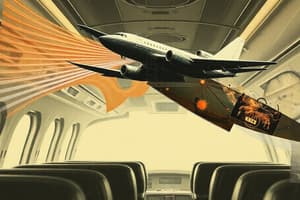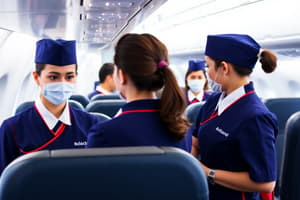Podcast
Questions and Answers
What is the typical altitude at which cabin pressure is maintained in aircraft?
What is the typical altitude at which cabin pressure is maintained in aircraft?
- 12,000 feet above sea level
- 8,000 feet above sea level (correct)
- 5,000 feet above sea level
- 10,000 feet above sea level
What is the term commonly used to describe the discomfort passengers feel due to changes in cabin pressure?
What is the term commonly used to describe the discomfort passengers feel due to changes in cabin pressure?
- Sinus squeezing
- Ear popping (correct)
- Altitude aches
- Pressure pain
Which of the following is NOT a symptom of short-term discomfort due to changes in cabin pressure?
Which of the following is NOT a symptom of short-term discomfort due to changes in cabin pressure?
- Nausea (correct)
- Headaches
- Sinus congestion
- Ear pain
What are some of the long-term health risks associated with exposure to lower cabin pressures?
What are some of the long-term health risks associated with exposure to lower cabin pressures?
How are changes in cabin pressure mitigated to ensure passenger comfort and safety?
How are changes in cabin pressure mitigated to ensure passenger comfort and safety?
Compared to other factors affecting aviation safety, how do the long-term health risks from lower cabin pressures rank?
Compared to other factors affecting aviation safety, how do the long-term health risks from lower cabin pressures rank?
Which aircraft component can be affected by metal fatigue due to frequent pressurization and depressurization cycles?
Which aircraft component can be affected by metal fatigue due to frequent pressurization and depressurization cycles?
How can changes in cabin pressure impact the tankage inside fuel lines?
How can changes in cabin pressure impact the tankage inside fuel lines?
What is the primary function of advanced pressurization control systems in aircraft?
What is the primary function of advanced pressurization control systems in aircraft?
Why are passengers advised to wear seat belts and avoid moving around the cabin during turbulence and high altitudes?
Why are passengers advised to wear seat belts and avoid moving around the cabin during turbulence and high altitudes?
What role do flight planning and risk assessment play in aviation safety related to cabin pressure?
What role do flight planning and risk assessment play in aviation safety related to cabin pressure?
Which area of research aims to develop lightweight materials resistant to fatigue for safer aircraft structures?
Which area of research aims to develop lightweight materials resistant to fatigue for safer aircraft structures?
What is a potential benefit of developing more efficient and reliable pressurization systems for aircraft?
What is a potential benefit of developing more efficient and reliable pressurization systems for aircraft?
Why is continuous pilot training important in dealing with sudden changes in cabin pressure?
Why is continuous pilot training important in dealing with sudden changes in cabin pressure?
'Variations in air pressure inside the engine can impact its __________.' Fill in the blank.
'Variations in air pressure inside the engine can impact its __________.' Fill in the blank.
What is a crucial aspect that airlines consider to minimize risks associated with cabin pressure fluctuations?
What is a crucial aspect that airlines consider to minimize risks associated with cabin pressure fluctuations?
Flashcards are hidden until you start studying
Study Notes
Cabin Pressure: Understanding the Effects on Aviation Safety
Cabin Pressure: Definition and Effects on Air Travel
Cabin pressure is the air pressure inside the aircraft cabin, which is typically maintained at a level of 8,000 feet above sea level (2,438 meters) to ensure passenger comfort and safety during flight. This altitude is maintained through the use of pressurization systems that maintain a balance between the outside atmospheric pressure and the cabin pressure. However, changes in cabin pressure can lead to various effects on aviation safety.
Effects on Passengers
Short Term Discomfort
Passengers may experience short-term discomfort due to changes in cabin pressure during flight. These symptoms include ear pain, headaches, and sinus congestion, which are caused by a change in air pressure inside the ears. This is commonly known as "ear popping" or "equalizing the pressure." The discomfort is temporary and subsides as the passengers adjust to the cabin altitude.
Long Term Health Risks
Long-term exposure to lower cabin pressures, such as those experienced during high-altitude flights, has been linked to health risks like deep vein thrombosis (DVT), pulmonary embolism (PE), and heart attacks. However, these risks are relatively low compared to other factors affecting aviation safety, such as equipment failure or pilot error.
Effects on Aircraft
Structural Integrity
Changes in cabin pressure can affect the structural integrity of aircraft components. For instance, metal fatigue can occur when an aircraft's structure experiences constant stress from frequent pressurization and depressurization cycles. This can weaken the material over time and increase the risk of component failure.
Impact on Engines and Systems
Changes in cabin pressure can also affect aircraft engines and systems. For example, pressurization changes during flight can cause the tankage inside fuel lines to expand or contract, potentially leading to leaks and other issues. Similarly, variations in air pressure inside the engine can impact its performance and efficiency.
Cabin Pressure Management and Safety Measures
Pressurization Controls and Monitoring
Aircraft are equipped with advanced pressurization control systems that monitor and regulate cabin pressure throughout the flight. These systems ensure that cabin altitude remains within safe limits for passengers and reduce discomfort caused by rapid changes in pressure.
Emergency Procedures and Training
Airlines and pilots follow strict emergency procedures when dealing with sudden changes in cabin pressure or depressurization events. Pilots receive specialized training on how to handle these situations safely and effectively. In addition, passengers are advised to wear seat belts and avoid moving around the cabin during turbulence and high altitudes to minimize risk of injury.
Flight Planning and Risk Assessment
Flight planning and risk assessment play crucial roles in ensuring aviation safety related to cabin pressure. By carefully considering factors such as weather patterns, aircraft design, and passenger comfort, airlines can minimize risks associated with cabin pressure fluctuations.
Future Developments: Improving Understanding and Mitigating Risks
Research continues to advance our understanding of cabin pressure effects on both passengers and aircraft. This knowledge is used to develop new technologies and improve existing ones that enhance aviation safety. Some examples include:
- Innovative Aircraft Materials: Research into lightweight materials that exhibit improved resistance to fatigue could lead to safer aircraft structures.
- Advanced Pressurization Systems: The development of more efficient and reliable pressurization systems could help maintain optimal cabin conditions while reducing energy consumption and costs.
- Passenger Comfort Technologies: As aircraft becomes larger and more complex, the focus shifts towards creating environments where passengers feel comfortable at higher altitudes.
- Improved Emergency Response Protocols: Continuous updates to emergency response protocols and ongoing pilot training ensure that crews remain prepared for any situation involving cabin pressure changes.
Overall, cabin pressure plays a significant role in aviation safety, affecting both passengers and aircraft. However, through careful management, monitoring, and technological innovations, risks associated with this factor can be effectively controlled, providing a safer travel experience for all involved.
Studying That Suits You
Use AI to generate personalized quizzes and flashcards to suit your learning preferences.




